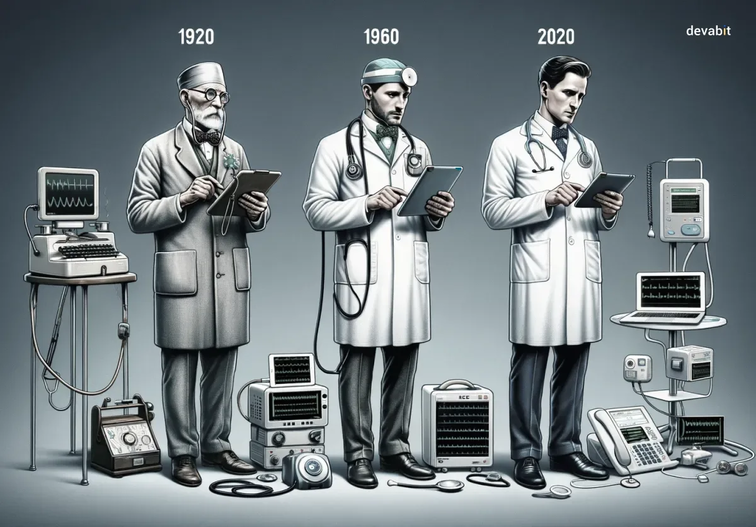Telemedicine’s future looks promising with advancements in technology and increased acceptance by both patients and healthcare providers. It will likely become a staple in modern healthcare.
Telemedicine leverages digital communication tools to provide healthcare services remotely. This technology allows patients to consult with healthcare providers from the comfort of their homes. As internet access and smartphone usage grow, telemedicine becomes more accessible and convenient. Healthcare systems benefit from reduced strain on resources, while patients enjoy quicker consultations.
Enhanced data security measures ensure patient information remains confidential. The integration of AI and wearable devices will further revolutionize telemedicine. These tools enable real-time monitoring and personalized care. The future of telemedicine is set to transform healthcare delivery, making it more efficient and patient-centric.
Telemedicine Evolution
The evolution of telemedicine has been remarkable. It has transformed how we receive healthcare. From its humble beginnings to the present, telemedicine continues to grow. Let’s explore its journey.
Early Beginnings
Telemedicine started many years ago. Early doctors used the telephone to give advice. They spoke to patients who were far away. This helped people in remote areas. It saved many lives.
Technological Advancements
Today, telemedicine uses advanced technology. Video calls let doctors see patients from anywhere. High-speed internet makes this possible. Mobile apps help people track their health. Wearable devices monitor vital signs.
Here are some key advancements:
- Video Conferencing: Doctors can diagnose through video calls.
- Mobile Health Apps: Apps help track daily health metrics.
- Wearable Devices: These devices monitor heart rate and more.
These tools make healthcare more accessible. They improve patient outcomes. Telemedicine is now a vital part of the healthcare system.
Current Trends
The future of telemedicine is evolving rapidly. Current trends are shaping how healthcare services are delivered. Let’s explore two significant trends in telemedicine today.
Virtual Consultations
Virtual consultations allow patients to see doctors online. This method saves time and increases access to care. Patients can discuss symptoms, get diagnoses, and receive prescriptions remotely.
- Convenient for patients with mobility issues
- Reduces waiting times
- Improves access for rural areas
Many platforms offer video calls, chat services, and appointment scheduling. These features make healthcare more accessible and efficient. Patients enjoy the comfort of consulting from home.
Remote Monitoring
Remote monitoring uses technology to track patients’ health data. Devices like wearables and sensors collect vital signs. This data is sent to healthcare providers in real-time.
| Device | Function |
|---|---|
| Smartwatches | Track heart rate and activity levels |
| Blood glucose monitors | Monitor blood sugar levels |
| Blood pressure cuffs | Measure blood pressure |
These devices help doctors monitor chronic conditions. They can detect issues early and adjust treatments quickly. Patients benefit from continuous care without frequent clinic visits.
Benefits Of Telemedicine
Telemedicine is the future of healthcare. It brings many benefits to patients and doctors. These benefits include increased accessibility and cost efficiency. Telemedicine makes healthcare easier for everyone.
Increased Accessibility
Telemedicine makes healthcare available to more people. Patients in remote areas can see doctors without long travel. People with disabilities can get care from home. Busy parents can schedule virtual visits for their kids. Telemedicine helps everyone get the care they need. It bridges the gap in healthcare access.
Cost Efficiency
Telemedicine saves money for patients and healthcare systems. Patients save on travel costs. They also save time, which means less missed work. Virtual visits are often cheaper than in-person visits. Healthcare systems save on overhead costs. Telemedicine reduces the need for large facilities. This makes healthcare more affordable for everyone.

Credit: appinventiv.com
Challenges To Overcome
The future of telemedicine is bright, but challenges still exist. Overcoming these hurdles is crucial for its widespread adoption. Below, we discuss some of the key challenges.
Regulatory Hurdles
Telemedicine faces numerous regulatory hurdles that vary by region. Different countries have different laws. These laws can make it hard to offer telemedicine services globally. Also, healthcare providers need to be licensed in each state they serve. This complicates the process.
Another issue is patient privacy and data security. The rules for data protection are strict. Providers must comply with regulations like HIPAA in the U.S. This adds another layer of complexity.
Technology Barriers
Technology is the backbone of telemedicine. However, not everyone has access to the needed technology. For telemedicine to work, patients need a reliable internet connection. Some areas still lack this basic requirement.
Healthcare providers also face technology barriers. They need to invest in secure systems. These systems must be easy to use and reliable. Training staff to use new technologies is another challenge. It takes time and resources to get everyone on board.
Below is a table summarizing the key technology barriers:
| Barrier | Description |
|---|---|
| Internet Access | Many areas lack reliable internet. |
| System Security | Secure systems are costly and complex. |
| Staff Training | Training takes time and money. |
Impact On Rural Areas
The impact of telemedicine on rural areas is transformative. This technology brings healthcare to underserved regions. Rural communities often face limited access to medical services. Telemedicine bridges this gap, providing essential care to those in need.
Bridging The Gap
Telemedicine connects doctors with patients in remote locations. It eliminates the need for long travel. Patients can consult specialists from their homes. This saves time and money. It also reduces the burden on local clinics.
Telemedicine offers various services:
- Virtual consultations
- Remote monitoring
- Access to specialists
- Online prescriptions
These services ensure comprehensive healthcare for rural populations. Technology makes healthcare more accessible. It brings quality medical services to remote areas.
Improved Health Outcomes
Telemedicine leads to better health outcomes. Patients receive timely medical advice. Early diagnosis and treatment prevent complications. Continuous monitoring helps manage chronic conditions. This improves the overall health of rural communities.
Benefits of telemedicine include:
- Reduced hospital visits
- Lower healthcare costs
- Better disease management
- Increased patient satisfaction
Telemedicine empowers patients. They become more involved in their health. It also provides education on disease prevention. This fosters healthier lifestyles in rural areas.
Here is a table showing the impact of telemedicine:
| Before Telemedicine | After Telemedicine |
|---|---|
| Limited access to specialists | Easy access to specialists |
| High travel costs | Reduced travel costs |
| Frequent hospital visits | Fewer hospital visits |
| Poor chronic disease management | Effective chronic disease management |
Telemedicine revolutionizes healthcare in rural areas. It ensures that everyone receives quality care. This technology is a game-changer for rural health.

Credit: devabit.com
Telemedicine Technologies
The future of telemedicine is bright with new technologies. These innovations are transforming healthcare. Telemedicine technologies make healthcare faster and more accessible. Let’s explore some of the key technologies driving this change.
Wearable Devices
Wearable devices are small gadgets you wear on your body. They track your health data in real-time. These devices collect data like heart rate, blood pressure, and sleep patterns.
Common examples include:
- Smartwatches
- Fitness trackers
- Health monitoring patches
Wearable devices send data to your doctor instantly. This helps in early detection of health issues. They also empower patients to manage their health better.
Ai And Machine Learning
AI and machine learning are changing telemedicine. These technologies analyze large amounts of data quickly. AI can predict health outcomes and suggest treatments.
Some uses of AI in telemedicine include:
- Virtual health assistants
- Automated appointment scheduling
- Predictive analytics for disease outbreaks
AI helps doctors make better decisions. It also reduces the workload on healthcare providers. AI-powered tools ensure patients get the best care possible.
Future Innovations
The future of telemedicine holds exciting innovations that will revolutionize healthcare. These innovations will make medical services more accessible and efficient. Among them, Augmented Reality and Blockchain Integration stand out as game-changers.
Augmented Reality
Augmented Reality (AR) will transform patient care. Doctors will use AR glasses to see 3D images of organs. This will improve surgeries and diagnostics.
- Enhanced Visuals: AR will provide detailed visuals of internal body parts.
- Remote Assistance: Experts can guide surgeries from afar using AR.
- Patient Education: Patients will understand their conditions better with AR visuals.
Blockchain Integration
Blockchain technology will bring more security to telemedicine. Patient data will be stored safely, reducing hacking risks.
| Advantage | Description |
|---|---|
| Data Security | Blockchain ensures patient data is encrypted and safe. |
| Transparency | Blockchain allows transparent tracking of medical records. |
| Efficiency | Smart contracts can automate processes, saving time. |
Blockchain will also simplify medical billing. Patients and providers will have a clearer view of financial transactions.
Global Adoption
The future of telemedicine is bright. Many countries now embrace this technology. The global adoption of telemedicine is transforming healthcare everywhere. Telemedicine brings medical services to remote places and busy cities. The benefits are clear and impactful.
Developed Nations
Developed nations are leading in telemedicine adoption. They have the technology and infrastructure. In the United States, many hospitals use telemedicine. Patients can consult doctors from home. This reduces hospital visits and saves time.
- High-speed internet is common.
- Advanced medical devices are available.
- Insurance often covers telehealth services.
In Europe, telemedicine is also popular. Countries like the UK and Germany invest heavily. They focus on improving access and quality.
| Country | Telemedicine Initiatives |
|---|---|
| USA | Wide use in hospitals and clinics |
| UK | Government-backed telehealth programs |
| Germany | Investments in digital health |
Developing Nations
Developing nations face challenges but are making progress. Telemedicine helps bridge gaps in healthcare. In India, telemedicine connects rural areas to urban hospitals. This helps patients in remote villages.
- Mobile phones are widely used.
- Telemedicine apps are growing.
- Non-profits support telehealth initiatives.
Africa sees growth in telemedicine too. Countries like Kenya and Nigeria use telehealth to fight diseases. They focus on maternal and child health. Telemedicine saves lives in these regions.
Developing nations benefit greatly from telemedicine. It helps overcome barriers and improves healthcare access.

Credit: www.boldbusiness.com
Frequently Asked Questions
Is There A Future In Telemedicine?
Yes, telemedicine has a promising future. It offers convenience, reduces healthcare costs, and improves patient access. Technology advancements will drive growth.
What Is The Forecast For Telemedicine?
The forecast for telemedicine is strong. It is expected to grow rapidly, driven by technological advancements and increased demand. Telehealth adoption rates are rising globally. This trend promises improved healthcare access and efficiency.
Will Telehealth Continue In 2025?
Yes, telehealth will continue in 2025. Advances in technology and growing demand for remote care will drive its expansion.
Is Telemedicine Here To Stay?
Yes, telemedicine is here to stay. Its convenience and efficiency make it a lasting healthcare solution. Patients enjoy easy access to medical care. Healthcare providers appreciate its cost-effectiveness. Telemedicine continues to evolve with technology, ensuring its relevance.
Conclusion
Telemedicine is revolutionizing healthcare by providing accessible, efficient, and cost-effective medical services. The future promises even greater advancements. Embracing telemedicine can improve patient outcomes and streamline healthcare processes. Stay ahead by integrating telemedicine into your practice. Keep an eye on emerging trends and technologies to fully benefit from this evolving field.

